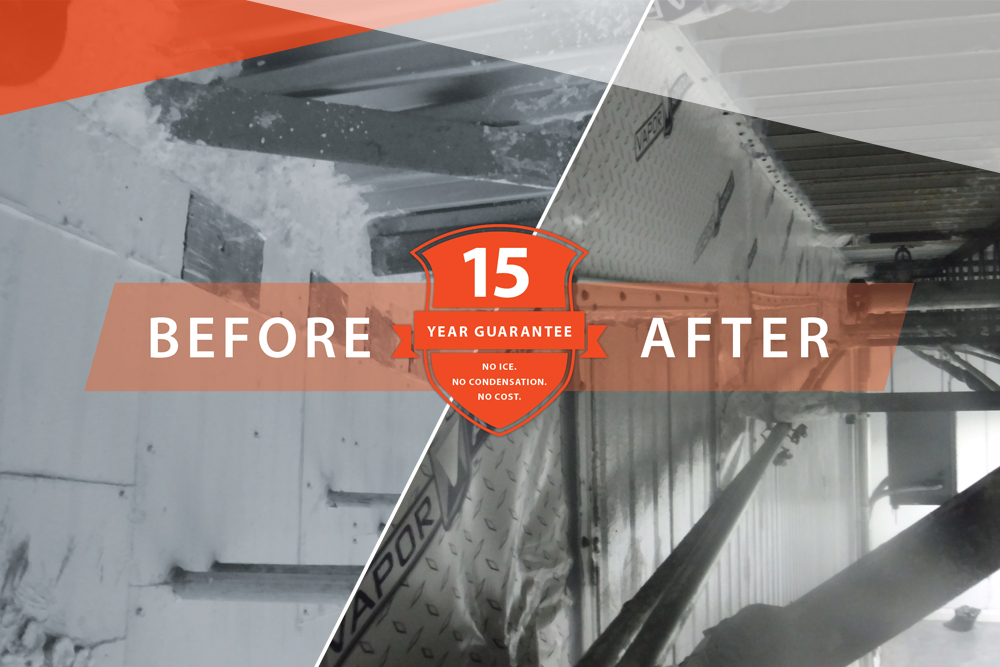BY RANDY BOGRAND, COO
We respect the knowledge and experience of our clients, we really do. In fact, listening to them when we arrive on-site to investigate the cause of their problems is one of our core values. They are the experts regarding their facility. But there is one practice that we do wish would go the way of the dinosaur. Since there’s no polite way to say it, you need to stop it with the spray foam, already.
It’s one of the most common “fixes” we encounter when called to a facility to conduct one of our free invasive forensic evaluations. Wherever we find hot spots, the trouble areas where temperatures are rising due to invasive Vapor Drive, we inevitably find this product.
We understand you asked your facilities maintenance engineering team for a solution, and they called around and found out what others had done. This stuff, this great stuff, came recommended. As an executive said in one of our presentations, “What’s wrong with spray foam? We’ve been using it for twenty years.”
“That” said our presenter, without a hint of irony, “Is the fricking problem.”
The Fricking Problem
But, to really explain why that is, let’s look at the product itself. Spray Foam is one of the easiest and most cost-effective methods of filling odd-shaped spaces – the kind that show up between roof structures and IMP walls in cold storage warehouses – that much is true.
It’s great for filling gaps. If you’ve ever used it to close a gap around a door or window on your home, you’ve experienced the immediate relief from cold or warm air invading your climate-controlled living quarters.
In our line of work, of course, it’s a bit more complex. In instances where Vapor Drive has become a challenge, moisture is typically an issue as well. This condensation is what leads to icing, which is seen as a serious potential environmental contaminant under FSMA and can lead to all kinds of problems from lost time to fines, to loss of your facility’s license.
So, what about moisture? Here again, spray foam looks like a workable solution. In fact, it repels moisture, and resists mold and mildew but in practice, here is what we find. About the time one-year rolls around on a new facility, just when most contractor’s warranty on that brand new facility runs out, spray foam begins to fail.
What operated like a perfectly sealed thermal envelope just a short time ago is now experiencing signs of definite Vapor Drive and threatening to become a major problem. So, facilities maintenance is called in, and the solution is……. more spray foam. We find so much of this in our installations that if we could melt it down and put it back in the can, we could solve any supply shortages for the next decade!
If the product does such a great job as a water repellant insulator, why would we use such strong terms to suggest it not be used? One of spray foam’s best attributes, is also its greatest weakness in this case. Once applied, it does not move. For the uninitiated, this sounds great. You put it where you want it, come back twenty years later, it’s still there. That’s true, however, the building is not.
You may think this is an exaggeration, but within your cold storage facility, you can experience thermal shifts causing expansion and contraction of materials up to more than one inch in a 24-hour period. The foam, for its part, will stay somewhat elastic, enough to keep its bond to all surfaces for quite a while, but in our extensive research, that seems to be somewhere between 6 and 12 months before the problems start to be noticed, which of course, is some time after the actual breach in your building’s “outer condom”, the building envelope, has already happened.
That’s right. What we’re saying is that trusting spray foam to protect your and your clients frozen and cold inventory, is like trusting a perforated condom!!! It might work. But then again if it doesn’t the results can be life changing for everyone involved.
So, now that we’ve “poked holes” in the go-to method for Vapor Barrier Discontinuity remediation, we can’t just leave you without a solution.
The Fricking Solution
While your contractor knew their job and built to spec, one thing got overlooked. The Spray Foam Vapor Barrier they installed simply could not keep up with building movement. What this means for you is that either now, or sometime in the future, when you least expect it, Vapor Drive will invade your temperature-controlled environments and wreak havoc.
When this happens, it doesn’t just ice up at the junctions where the vapor drive is taking place. Condensation and Ice begins, and it spreads. Once moisture is introduced inside of what was a sealed envelope, it will continue to increase, invading the surrounding insulation fibers, and reducing the R value of your entire structure. Over time this creates a convection effect making it literally impossible for your cooling systems to keep up.
The first cost will be in your energy bill. Long before you see icing on the interior, it can develop in the ribs of your roof structure, around the spray foam and even in the insulation itself, reducing the efficiency of the entire plant and straining the units cooling your facility. We’ve seen energy usage spike as much as 20-38% over baseline, and at today’s prices, you can figure out what will happen to your bottom line.
What you need is a method of remediating this problem, without expensive shutdowns, or new construction. Vapor Armour is the only patented system designed to provide just that, and we are the only authorized installer. What’s so special about Vapor Armour? You can find out everything you’ve ever wanted to know in our upcoming two-part series on the process. But, here, in short, it stops air.
Once a building experiences Vapor Barrier Discontinuity, the only option for continued operation is to restore the seal. Vapor Armour provides an airtight, waterproof, flexible membrane that can be locked in place on your roof, cover the top of the wall, and be locked in place below the roof/wall juncture, creating an air and moisture tight seal over the joint between wall and roof structure. This is a permanent fix.
The elasticity of our product is designed to withstand even the most severe building movement. It’s been proven in over twenty million square feet of cold storage so far and growing. That, coupled with our proprietary thermal ribbon replacement gives you fifteen years of worry- and cost – free security against invasive vapor drive, condensation, and icing. When we say cost free, we mean it. Our warranty provides coverage against defects and failure in our system in areas where the Vapor Armour barrier is installed. We will cover the entire cost of material and labor to repair, or replace any defective, or failing Vapor Armour product for up to 15 years.
Now, in some cases, this is enough. But in some of the facilities where we conduct our invasive forensic assessments, we find extensive roof contamination as well. That’s why Vapor Armour made the decision to partner with a national roofing contractor with low-temp divisions. These professionally trained roofing technicians install a state-of-the-art membrane roofing system that adds another five years to the already strong warranty coverage.
That means that if we replace your roof and install Vapor Armour, the installation is guaranteed for 20 years. It and the Vapor Armour barrier are covered for two full decades, cost and worry free to you. You can learn about the incredible energy savings our client’s experience, which has them paying off this system in as little as three years in reduced cost.
We’d love to hear from you as soon as possible. We know your issues are time sensitive. Contact us today to conduct a free and thorough invasive forensic assessment of your facility. We will show you exactly where the problems are, and what we can do to alleviate them. You’ll never have to trust a leaky system again.


